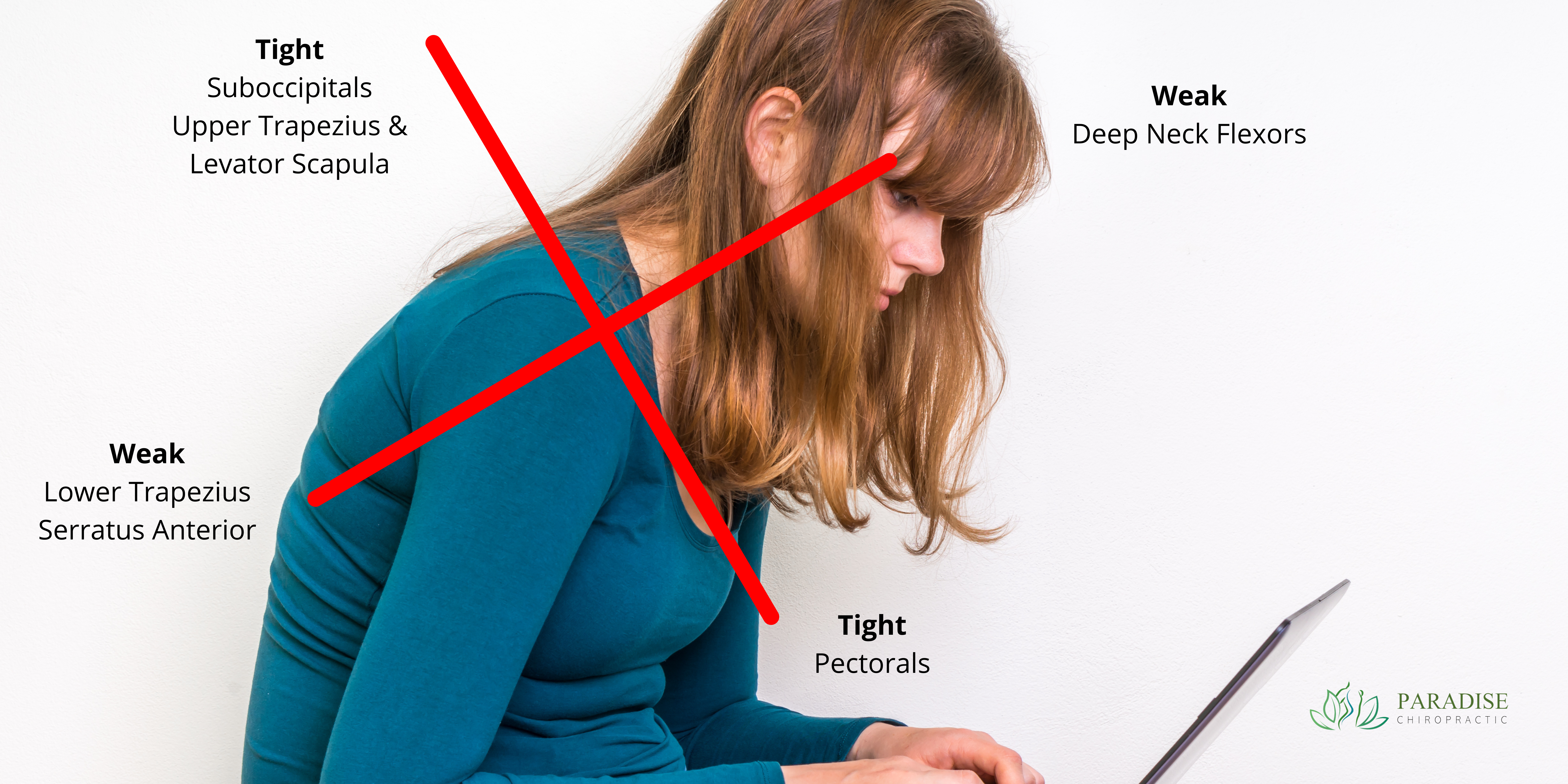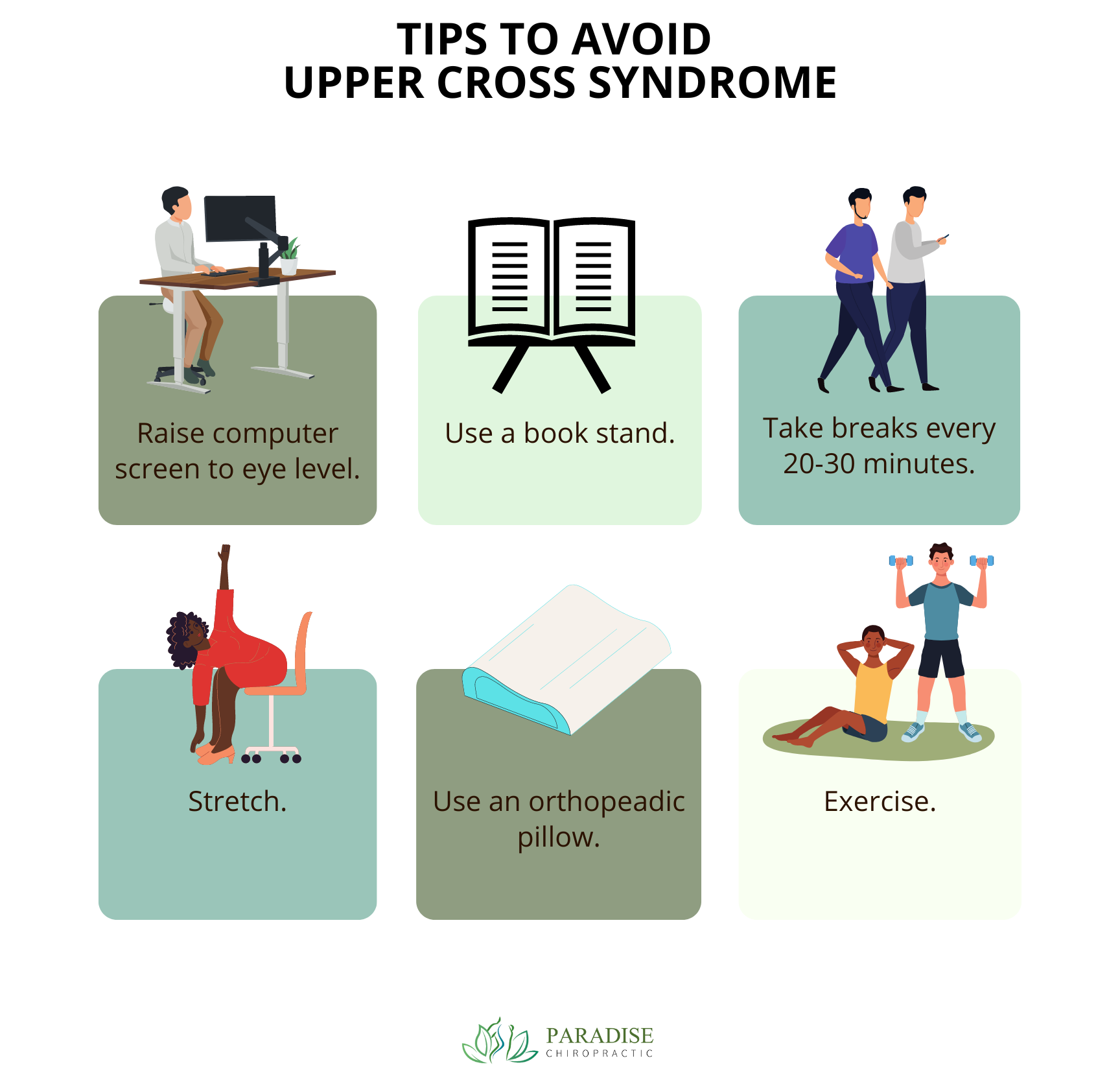
 |
Dr. Kimberly Huynh September 29, 2022 · 10 min |
Are you or anyone you know always slouching?
Do you have a constant achy neck, shoulder, or upper back?
You may be suffering from one of the most common spinal disorders called “upper cross syndrome.”
Having ‘bad posture’ can over time cause specific muscles to become tight and others to become weak. As the name suggests, upper cross syndrome (UCS) shows a “cross” pattern in side view of commonly tight ‘overactive’ muscles including the upper trapezius, levator scapula, to pectorals, and a pattern of weak ‘inactive’ muscles including the deep neck flexors, lower trapezius, and serratus anterior.
UCS is best represented in the picture below.

The tight ‘overactive’ muscles lead to short and tight postural muscles. Tight muscles fatigue easily and therefore need oxygen leading to that “burning aching” pain. The weak ‘inactive’ muscles lead to long and inhibited muscles.
Over time this cross pattern can lead to forward head posture with protracted shoulders along with other problems including weakness and pain. The imbalance causes the spine to pull forward, significantly increasing the amount of stress on the supporting postural muscles.
UCS can also lead to breathing difficulties from less space for lungs to expand due to ‘slouchy’ posture, spinal issues, and to less range of motion.
Many factors can contribute to UCS. Individuals with a sedentary lifestyle including long hours of sitting or repetitive bending can contribute to bad posture and muscle imbalances. This can include students, office workers, physical laborious workers, to individuals with chronic use of television, smartphones, and tablets. UCS can also be seen in athletes, especially swimmers and weightlifters from overuse of the neck, shoulders, and upper back muscles.
Injuries from whiplash to rotator cuff tears can also lead to UCS. Injuries can lead to functional compensation and muscle imbalances. These can cause altered movement patterns and pain.
Your visit with your health practitioner includes a detailed history and physical examination.
Commonly seen in postural evaluation for people with UCS includes:
1) Anterior head carriage
2) Forward and rounded shoulders
3) Protracted scapula aka scapular ‘winging’
4) Internally rotated humerus
5) Increase thoracic kyphosis (hunch back)
In addition, patients may have a limited range of motion in the neck, shoulders, and upper back, weak muscles during muscle testing, and pain during palpation.
Having poor upper back and neck posture can lead to:
- Neck pain
- Upper back pain
- Headaches
- TMJ dysfunction
- Breathing difficulties
By targeting these muscle imbalances directly at the source and working on stretching and strengthening those muscles, we can help alleviate UCS pain to help you live a pain-free life.

Chiropractic Adjustments
Chronic forward head posture and rounding of shoulders may lead to neck and upper back joint dysfunction. Chiropractic adjustments are extremely effective at restoring natural motion to these joints and relieving joint stresses. Increased joint motion can relieve tightness and discomfort, improve alignment to allow better posture, and promote deeper breathing.
Aside for adjusting, soft tissue therapy is performed as well as therapeutic rehab, lifestyle and ergonomic advice is given. All can help restore normal biomechanics to ensure a pain-free back.
Massage
With tailored treatments, the registered massage therapist will help muscles relax so they may be more easily moved to the right position over time. Relaxing the muscles that are most affected by UCS can help release the pain and tightness and alleviate anything stopping the body from standing or sitting up properly.
Active Rehab
Active rehab will focus on retraining and rebalancing muscular relationships. Our experienced kinesiologist will customize your exercises for specific needs. Common exercises include engaging and strengthening the upper back and deep neck flexors to stretching shoulders and chest muscles. Abdominal breathing is also recommended allowing for deeper quality breaths and core muscle engagement. From using body weight, dumbbells, exercise balls, to resistance bands there are exercises for everyone of different fitness backgrounds.
Starting off with good posture is a good habit. Having an ergonomic work/school set up can help as well.
Here are some tips and tricks to help with symptoms of UCS:

Upper cross syndrome is treatable and also preventable. Alongside with the tips given above, let us help you and give you lasting improvement. Every treatment plan is individualized, and if followed it is an entirely manageable condition. Book with our experienced practitioners.
For a complimentary consultation or any other inquiries give us a call at (604) 496-0626, email at info@paradisechiropractic.ca, or book online at https://paradisechiropractic.janeapp.com .